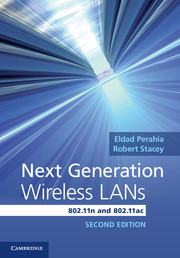Book contents
- Frontmatter
- Contents
- Foreword
- Preface to the first edition
- Preface to the second edition
- List of abbreviations
- Chapter 1 Introduction
- Part I Physical layer
- Chapter 2 Orthogonal frequency division multiplexing
- Chapter 3 MIMO/SDM basics
- Chapter 4 PHY interoperability with 11a/g legacy OFDM devices
- Chapter 5 High throughput
- Chapter 6 Robust performance
- Chapter 7 Very High Throughput PHY
- Part II Medium access control layer
- Part III Transmit beamforming, multi-user MIMO, and fast link adaptation
- Index
- References
Chapter 4 - PHY interoperability with 11a/g legacy OFDM devices
from Part I - Physical layer
Published online by Cambridge University Press: 05 June 2013
- Frontmatter
- Contents
- Foreword
- Preface to the first edition
- Preface to the second edition
- List of abbreviations
- Chapter 1 Introduction
- Part I Physical layer
- Chapter 2 Orthogonal frequency division multiplexing
- Chapter 3 MIMO/SDM basics
- Chapter 4 PHY interoperability with 11a/g legacy OFDM devices
- Chapter 5 High throughput
- Chapter 6 Robust performance
- Chapter 7 Very High Throughput PHY
- Part II Medium access control layer
- Part III Transmit beamforming, multi-user MIMO, and fast link adaptation
- Index
- References
Summary
One of the functional requirements in the development of the 802.11n standard was that some modes of operation must be backward compatible with 802.11a (and 802.11g if 2.4 GHz was supported) as described in Stephens (2005). Furthermore, the 802.11n standard development group also decided that interoperability should occur at the physical layer. This led to the definition of a mandatory mixed format (MF) preamble in 802.11n. In this chapter, we first review the 802.11a packet structure, transmit procedures, and receive procedures to fully understand the issues in creating a preamble that is interoperable between 802.11a and 802.11n devices. For further details regarding 802.11a beyond this review, refer to clause 18 in IEEE (2012). Following this overview, the mixed format preamble, which is part of 802.11n, is discussed.
11a packet structure review
The 802.11a packet structure is illustrated in Figure 4.1.
The Short Training field (STF) is used for start-of-packet detection and automatic gain control (AGC) setting. In addition, the STF is also used for initial frequency offset estimation and initial time synchronization. This is followed by the Long Training field (LTF), which is used for channel estimation and for more accurate frequency offset estimation and time synchronization. Following the LTF is the Signal field (SIG), which contains the rate and length information for the packet. Example rates are BPSK, rate ½ encoding and 64-QAM, rate ¾ encoding. Following this is the Data field. The first 16 bits of the Data field contain the Service field. An example of an 802.11a transmit waveform is given in Figure 4.2.
Information
- Type
- Chapter
- Information
- Next Generation Wireless LANs802.11n and 802.11ac, pp. 62 - 104Publisher: Cambridge University PressPrint publication year: 2013
